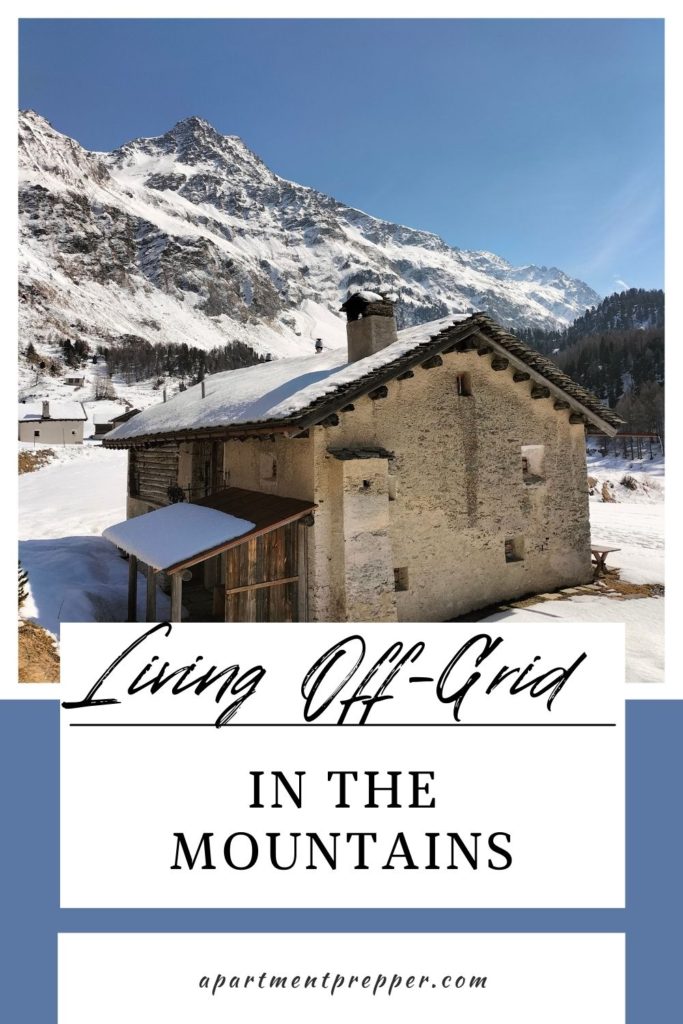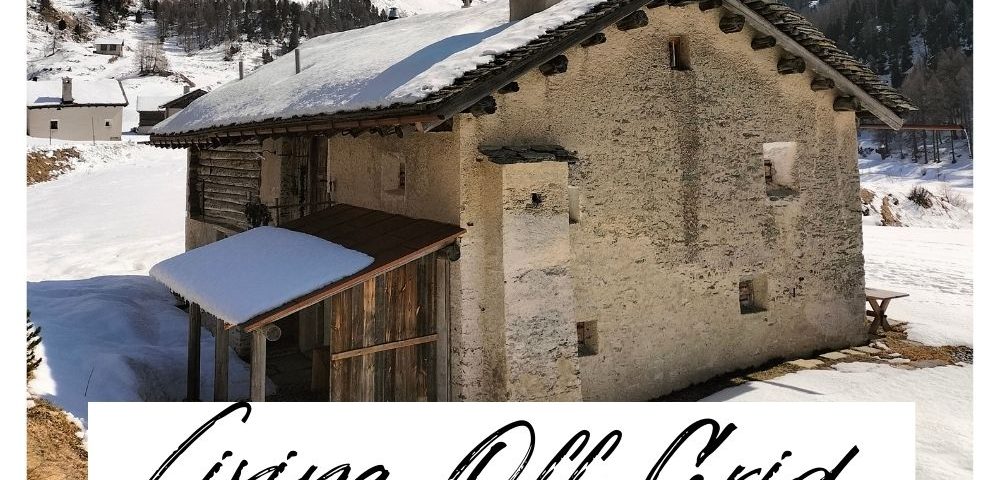by Kyt Lyn Walken
Foreword
“It is not the mountain we conquer but ourselves.” – Sir Edmund Hillary
Climbing mountains, as well as living at a high altitude, isn’t for everyone. Besides the complexity of it, and all the preparedness required to face such an extreme way of life, mountains still represent the harshest environment for humankind to adapt to.
For a high altitude, we refer to an altitude between 1500 meters and 1800 meters above sea level (4921 – 5905 feet). The features are intrinsically connected to:
- morphology of the terrain
- presence or absence of easy access/exit points and routes
- presence or absence of limited urbanized areas
- climate and local weather conditions
- local fauna and flora
just to name the main ones.
In this article, we will cover what living off grid in the mountains takes in terms of knowledge, skills, preparation, and, obviously, endurance.
The Alpine-style – benefits
I was born and raised in the Alps, so I am perfectly familiar with the so-called “Alpine Style” of living. You may get some ideas if you google it: you will immediately get some results related to a chalet made of stones and wood located in the breathtaking frame of the Alps.
These photographs are mostly related to countries like Switzerland, South Tyrol, and Austria. I am well aware of the fascination these pics can have on the minds of those who are currently living in big, metropolitan areas which offer the opposite scenario, consumed by noise, pollution, and scarcity of green areas.
I know the above-mentioned countries very well due to my frequent trips for running my Mantracking classes or for hikes and I can guarantee you that it is almost like entering a parallel world.
In fact, silence, peace, and purity are the main concepts you have in mind when you look at these photographs. That is exactly why a good amount of people decided to get rid of their previous life in cities by embracing a new lifestyle, purchasing some terrain in mountain areas, or renovating old, traditional buildings. We will soon cover in detail this point.
Nevertheless, it goes without saying that this life involves a lot of factors that most people ignore or, simply, do not pay attention to in the phase of relocating.
Worldwide speaking, life in the mountains has never been an easy one and only a few populations were actually able to start and conduct it successfully throughout the centuries. The price to pay is extremely elevated. We can calculate it in terms of isolation, poverty, and toughness.
Some good books on the market can guide you into the discovery of how people achieve such a living. One for all is “Mountains of the Mind. A history of a fascination” (2003) by the British author Robert McFarlane, who accurately described the rampage of mountains in the collective imagination. McFarlane brings the attention of the readers into a journey from the time mountains used to be only an ugly amount of rocks to the moment in which men and women started to establish communities on them until the day the fascinating tradition of climbing officially began.
Pros and cons of living at high altitude
It has been often said that there are only two environments in the whole world in which mankind can really find extreme issues in establishing civilization (consequentially founding villages, infrastructures, and so on): deserts and mountains.
The tough nature of these two areas may preclude any possible form of life, nonetheless, mountains, at the above-mentioned quote between 1500 meters and 1800 meters above sea level (4921 – 5905 feet) can still offer some resources for those who want to relocate over there.
In fact, we are not talking about craggy and rocky environments, but high altitude valleys (like, for example, Engadine in Switzerland) or platforms where vegetation is still present, and fauna and flora are lush.
Let’s see more in detail the pros and cons of it.
Pros
For health
Good air quality
Major Vitamin D assimilation throughout the sun
Silence
Peace
Multiple possibilities of daily activities, including sports like hiking, skiing, climbing, cycling, and so on
Lower risk of heart diseases
For mind & spirit
More happiness
Becoming able to adapt to circumstances
Focus on daily problems – lower the risk of overthinking
Enjoying small things in life
Better communication with ourselves
Focus on improving
Cons
For health
Sense of fatigue for high pressure
Dizziness
Acute Mountain Sickness (especially during climbs!)
please notice that those who suffer from serious heart diseases should consider moving to a lower altitude to prevent any possible deterioration of their health
For mind & spirit
Solitude
Melancholy (especially with bad weather)
Incapacity to adapt to the new life due to the absence of what a big city may offer in terms of fun activities, social life, and so on.
With that said, let’s move on to consider the features that a house at a high altitude should include by learning some lessons from the past.
What type of house do you need when living at a high altitude?
Houses in the mountains have been always built with an astonishing technique focused on adaptation to extreme environmental conditions such as temperatures, temperature ranges, precipitation, wind, land inclinations, snow loads, landslides, and avalanches, especially if located in an isolated area.
The ideal solution always comes from a methodical observation of the context and its resources. Mountaineer architecture has always been very a simple and functional response to the concrete needs of those who lived in the mountains in the past.
The house in the mountains was the place of habitation and human activities, agricultural, artisanal, professional, and commercial, in a single block or divided into several nearby buildings.
Back in the day, in fact, the house could coexist in the same block and the spaces were actually intended for animals, product processing, and stocks. You should take this solution into serious consideration if you have in mind to have some livestock like cows, sheep, and goats. Their presence, even if breeding is never an easy task to accomplish, especially if you have a main job, can ensure you the major livelihood means to carry on an independent life, especially if paired with permaculture.
If this is your aim, your house should answer criteria related to high functionality.
Usually, alpine buildings had a square or rectangular plan and a gabled roof, and a solid stone plinth.
The rest of the whole house can feature:
wood (including the cover)
stone (to ensure better insulation)
or a combination of both of them.
The stone could be exposed or plastered with lime mortar. This type of irregular plaster that followed the movement of the underlying stone provides the house a natural appearance that was better integrated into the environmental context.
Stone was used for constructions that required safety, people and agricultural products, and durability.
The stone base rested on the most consistent part of the land, without foundations.
The alpine house is always integrated into the landscape, usually in the nearby of other houses, water sources, and roads, and with good exposure to direct sun.
Renovating or building?
If your desire is to relocate into a traditional house, you may check for any economic aid to renovate: in some cases, in fact, you can receive some benefits. Small mountaineer communities, in fact, tend to preserve what yet exists in a perspective of the protection of the whole environment.
You certainly need to stay stuck to architectural constraints, but the satisfaction of living in a house with a noticeable history is always incredibly high.
Living off-grid in traditional buildings necessarily requires the adoption of some solutions like solar panels and
wood stoves to ensure you have the proper power you need in according to the size of the whole house and the activities you need to carry on inside of it.
Property security is also an important point that needs to be covered, as isolated houses are often the dream of burglars and even vandals. Installing CCTV cameras and adopting a couple of guard dogs are good ways to increase your family’s security.
Conclusion
The builders of traditional mountain houses deal with the relationship with the territory, functionality, insulation, ventilation, aesthetics, communication, and economy.
Living off-grid at high altitudes always goes with intelligent technical solutions which arise from observing of the context and its resources. Try building your home with the few materials available locally.
Particular attention to the functionality of the building can create the conditions and spaces to support the whole family economy.
About the author
Kyt Lyn Walken is Official Representative and Instructor for Hull’s Tracking School (Virginia) and Antipoaching Certified Ranger for Conservation Rangers Operations Worldwide Inc. (Colorado).
She’s a long time Prepper and Survivalist and she wrote several articles and essays on this topic.
If you found this article interesting or helpful, please consider helping us out (without costing you anything)! We are an affiliate of Amazon.com, which means we received a small commission if you click through one of our Amazon links when you shop, at totally no cost to you. This helps keep the lights on at the blog. Thanks!


